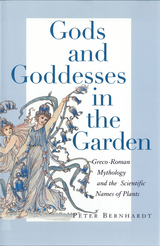5 books about Bernhardt, Peter

Darwin's Orchids
Then and Now
Edited by Retha Edens-Meier and Peter Bernhardt
University of Chicago Press, 2014
For biologists, 2009 was an epochal year: the bicentennial of Charles Darwin’s birth and the 150th anniversary of the publication of a book now known simply as The Origin of Species. But for many botanists, Darwin’s true legacy starts with the 1862 publication of another volume: On the Various Contrivances by Which British and Foreign Orchids Are Fertilised by Insects and on the Good Effects of Intercrossing, or Fertilisation of Orchids. This slim but detailed book with the improbably long title was the first in a series of plant studies by Darwin that continues to serve as a global exemplar in the field of evolutionary botany. In Darwin’s Orchids, an international group of orchid biologists unites to celebrate and explore the continuum that stretches from Darwin’s groundbreaking orchid research to that of today.
Mirroring the structure of Fertilisation of Orchids, Darwin’s Orchids investigates flowers from Darwin’s home in England, through the southern hemisphere, and on to North America and China as it seeks to address a set of questions first put forward by Darwin himself: What pollinates this particular type of orchid? How does its pollination mechanism work? Will an orchid self-pollinate or is an insect or other animal vector required? And how has this orchid’s lineage changed over time? Diverse in their colors, forms, aromas, and pollination schemes, orchids have long been considered ideal models for the study of plant evolution and conservation. Looking to the past, present, and future of botany, Darwin’s Orchids will be a vital addition to this tradition.
Mirroring the structure of Fertilisation of Orchids, Darwin’s Orchids investigates flowers from Darwin’s home in England, through the southern hemisphere, and on to North America and China as it seeks to address a set of questions first put forward by Darwin himself: What pollinates this particular type of orchid? How does its pollination mechanism work? Will an orchid self-pollinate or is an insect or other animal vector required? And how has this orchid’s lineage changed over time? Diverse in their colors, forms, aromas, and pollination schemes, orchids have long been considered ideal models for the study of plant evolution and conservation. Looking to the past, present, and future of botany, Darwin’s Orchids will be a vital addition to this tradition.
[more]

Gods and Goddesses in the Garden
Greco-Roman Mythology and the Scientific Names of Plants
Bernhardt, Peter
Rutgers University Press, 2008
Zeus, Medusa, Hercules, Aphrodite. Did you know that these and other dynamic deities, heroes, and monsters of Greek and Roman mythology live on in the names of trees and flowers? Some grow in your local woodlands or right in your own backyard garden.
In this delightful book, botanist Peter Bernhardt reveals the rich history and mythology that underlie the origins of many scientific plant names. Unlike other books about botanical taxonomy that take the form of heavy and intimidating lexicons, Bernhardt's account comes together in a series of interlocking stories. Each chapter opens with a short version of a classical myth, then links the tale to plant names, showing how each plant "resembles" its mythological counterpart with regard to its history, anatomy, life cycle, and conservation. You will learn, for example, that as our garden acanthus wears nasty spines along its leaf margins, it is named for the nymph who scratched the face of Apollo. The shape-shifting god, Proteus, gives his name to a whole family of shrubs and trees that produce colorful flowering branches in an astonishing number of sizes and shapes.
Amateur and professional gardeners, high school teachers and professors of biology, botanists and conservationists alike will appreciate this book's entertaining and informative entry to the otherwise daunting field of botanical names. Engaging, witty, and memorable, Gods and Goddesses in the Garden transcends the genre of natural history and makes taxonomy a topic equally at home in the classroom and at cocktail parties.
[more]

The Rose's Kiss
A Natural History of Flowers
Peter Bernhardt
University of Chicago Press, 2002
"An engaging botanical overview of flowers."-New York Times Book Review
In The Rose's Kiss, Peter Bernhardt presents a fascinating and wide-ranging look at the natural history of flowers—how they look, what they do, and their often hidden interactions with the surrounding environment and other living organisms upon which they depend for their survival. You'll discover why flowers are so colorful, how they evolved, and how insects exploit them for their nectar. This is a book for all flower lovers, from naturalists and gardeners to poets and botanists.
In The Rose's Kiss, Peter Bernhardt presents a fascinating and wide-ranging look at the natural history of flowers—how they look, what they do, and their often hidden interactions with the surrounding environment and other living organisms upon which they depend for their survival. You'll discover why flowers are so colorful, how they evolved, and how insects exploit them for their nectar. This is a book for all flower lovers, from naturalists and gardeners to poets and botanists.
[more]

The Rose's Kiss
A Natural History Of Flowers
Peter Bernhardt
Island Press, 1999
Flowers bring joy and beauty to our lives, from the smallest patch of daisies outside our window to the elaborate floral decorations on display at weddings, banquets, and funerals. As well as offering aesthetic benefits, they teach us much about how the world works -- each blossom is a living factory that manufactures organs and compounds ranging from the flavonoids that make a rose red to the pollen that gives us hayfever.In The Rose's Kiss, botanist Peter Bernhardt rekindles our sense of wonder at the plant life all around us. He presents a fascinating and wide ranging look at the natural history of flowers -- their forms and functions as well as their hidden interactions with the surrounding environment and the other living organisms they depend upon for survival. Using both familiar and exotic examples, he examines: flower architecture, including the wonderfully descriptive names of floral parts and their respective roles in a plant's life-cycle the secret exchange between a bud and its environment that determines blooming time and the lifespan of individual blossoms colors, scents, and other mechanisms that plants use to attract pollinators and keep them returning season after season the incredible diversity of organisms that pollinate plants -- cockroaches, flies, moths, parrots, hummingbirds, bats, and others extinct plants and their fossil blossoms, showing the evolution of flowering plants over the past 125 million years and much moreDelightfully interwoven with intriguing facts and stories from history, folklore, and mythology, The Rose's Kiss is a wonderful example of literary science writing at its best. It should hold wide appeal for nature lovers, garden enthusiasts, and anyone interested in learning more about the inner workings of the natural world.
[more]

Wily Violets and Underground Orchids
Revelations of a Botanist
Peter Bernhardt
University of Chicago Press, 2003
In this book, Peter Bernhardt takes us on a grand tour of the botanical realm, weaving engaging descriptions of the lovely shapes and intriguing habits of flowering plants with considerations of broader questions, such as why there are only six basic shapes of flowers and why the orchid family is so numerous and so bizarre. Everyone from amateur naturalists and gardeners to plant scientists will find Wily Violets and Underground Orchids a lively guide to botanical lore.
[more]
READERS
Browse our collection.
PUBLISHERS
See BiblioVault's publisher services.
STUDENT SERVICES
Files for college accessibility offices.
UChicago Accessibility Resources
home | accessibility | search | about | contact us
BiblioVault ® 2001 - 2024
The University of Chicago Press









